Genomics Core Facility
The Genomics Core Facility, located on the 17th floor of the New College Building, 245 N. 15th Street in Philadelphia, is home to a variety of instrumentation platforms available to assist researchers across Drexel University with gene (DNA and RNA) sequencing and nucleic acid quantitation.
Download Brochure

Drs. Bhawati Sen, Genomics Core Facility (GCF) lab manager (left) and Azad Ahmed, GCF assistant director (right), manning the GCF booth at Drexel University's 2022 Discovery Day, Philadelphia Convention Center.
Available Platforms
DNA/RNA Sequencers
Sequence-Specific Nucleic Acid Quantitation/Quality Check/Sizing
RNA Expression Analysis
Sequencing Platforms
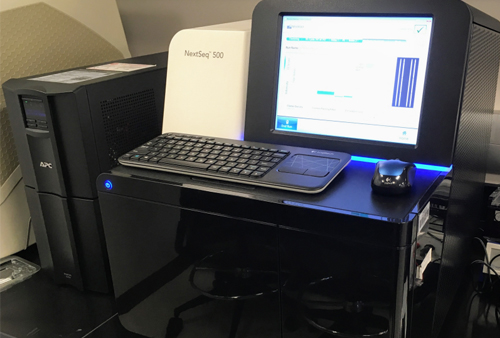
Illumina NextSeq 500
- Bench top: slots in between MiSeq and HiSeq
- 120 gigabases of sequence; 40x coverage of human genome/run
- Expected upgrades over next year or so should take in to 3 human genomes/run
- 12 and 30 hour cycle times
- Short reads: 1x75 bases; 2x75 bases; 2x150 bases
- Has two flow cell configurations – mid (132M clusters) and high (400M clusters)
- 1-16 exomes/run
- 1-20 transcriptomes/run
- 6-96 targeted panels/run
- 12-40 gene expression profiling samples/run
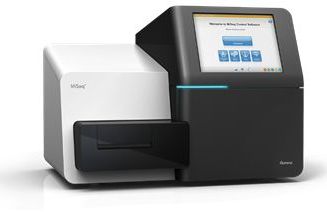
Illumina MiSeq
- Up to 15 gigabases of output
- Read Length: 1x36 bp, 2x25 bp, 2x75 bp, 2x150 bp, 2x250 bp, 2x300 bp
- ~4 to ~56 hour run time
- 4 M to 44-50 M clusters
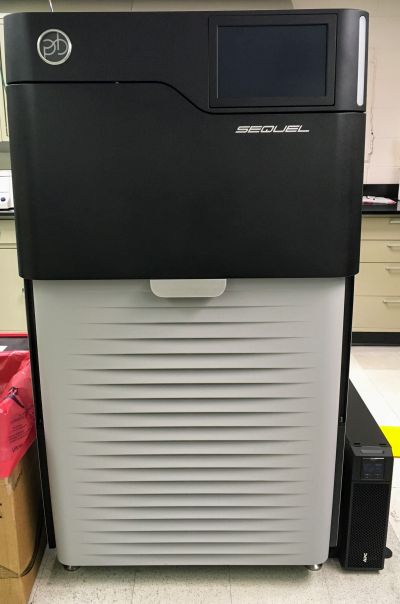
Pacific Biosciences Sequel System (PacBio)
- 1 million ZMWs per SMRTcell
- Longest average read lengths
- Highest consensus accuracy
- Uniform coverage
- Simultaneous epigenetic characterization
- Single-molecule resolution
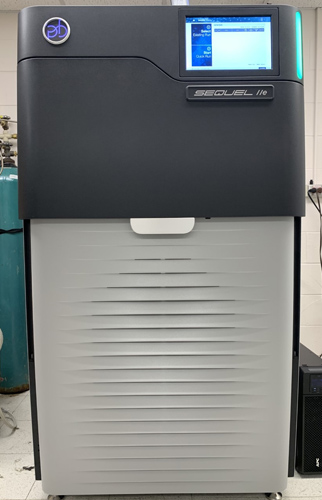
Pacific Biosciences Sequel System IIe (PacBio)
Based on the proven performance of the Sequel II system, the Sequel IIe system delivers:
- Direct access to the only highly accurate long reads: PacBio HiFi reads
- Deeper biological insights, less data processing, and faster results thanks to the unmatched clarity of HiFi reads
- Reliable and affordable high-throughput sequencing for a broad range of applications
- 8 million ZMWs per SMRTcell
Key benefits of HiFi sequencing on the Sequel IIe system:
- Better data for superior results with lower coverage, from a single technology
- Less time spent on data processing and analysis for faster answers
- Cost savings at every step of your sequencing pipeline
Back to Top
Nucleic Acid Quantitation/Quality Check/Sizing Platforms
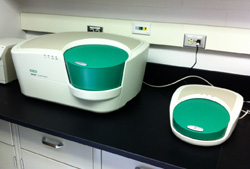
Bio-Rad QX-200 Droplet Digital PCR
- Absolute quantitative limiting dilution PCR for DNA or RNA – based on Poisson distribution
- Analogous to 454 emulsion technology – partitions ddPCR mix into 20K nL droplets (one template max/droplet)
- EvaGreen or Taqman-type hydrolysis probe-based
- Droplet digital PCR instruments
- C1000 touch thermal cycler – performed on partitioned droplets
- PX1 plate sealer
- Droplet generator
- Droplet reader – droplets are sipped and run single file past a two-color detector
- # of positive and negative droplets is counted to give discrete quantitative data
- No need for standard curves
- NGS library quantitation for multiplex strategies
- Gene expression studies
- Copy number variations
- Viral load
- Cancer biomarkers
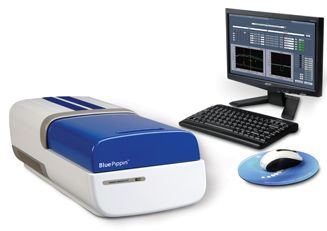
BluePippin
- DNA size selection for next-gen sequencing, with pulsed field
- 100bp – 50kb
- Collect HMW DNA with high-pass filtering
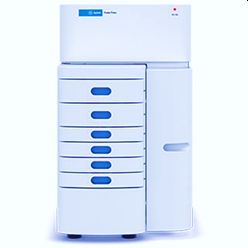
Femto Pulse System
- Large fragment resolution – separate high molecular weight DNA smears and fragments through 165 kb
- Achieves 10 times higher sensitivity for nucleic acid smears and up to 100 times higher for nucleic acid fragments
- Detects nucleic acids down to 50 fg/µL input concentration, making the Femto Pulse System ideal for long-read NGS QC, gDNA, small RNA, or cfDNA analysis from low-concentration samples
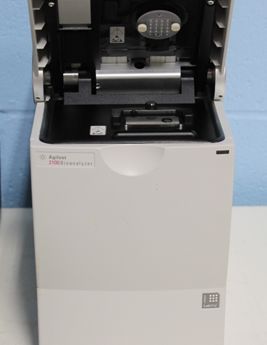
2100 Bioanalyzer Instrument
- Objective assessment of sizing, quantitation, integrity and purity from DNA, RNA and proteins
- Minimal sample volumes are required for an accurate result

Qubit 4 Fluorometer
- Latest version of the popular Qubit fluorometer
- Accurately measure DNA, RNA and protein quantity
- RNA integrity and quality
- High levels of accuracy using only 1–20 μL of sample
Back to Top
RNA Expression Analysis Platform
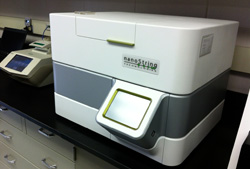
nanoString
- nCounter analysis system – for targeted quantitative nucleic acid analyses
- Highly multiplexable – can look at up to 800 targets simultaneously
- Digital – no amplification, uses nanotech colored barcodes
- Each target unique bar code
- Sensitive – more sensitive than PCR-based systems
- DNA (CNV), mRNA, miRNA, lncRNA, ChIP-string analysis
- Very small sample sizes
- In vivo studies of pathogen gene expression
- Single cell expression
- Workflow
- Set up hybridization between target and nCounter probes
- Hybridize and wash ON on robotic prep station
- Move hybridization cartridge to digital analyzer
- Unparalleled sensitivity (< 1 copy/cell), reproducibility (R2 > .99), and dynamic range (5 logs)
Back to Top